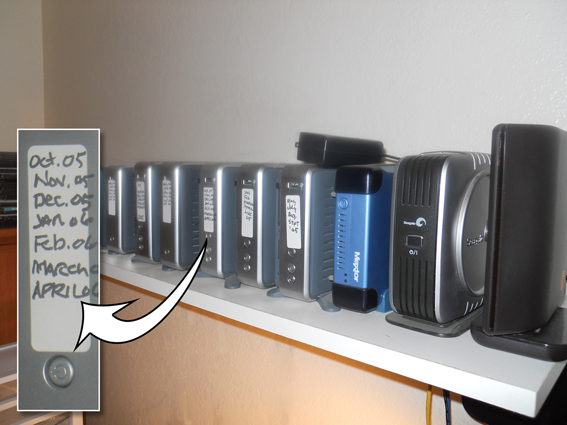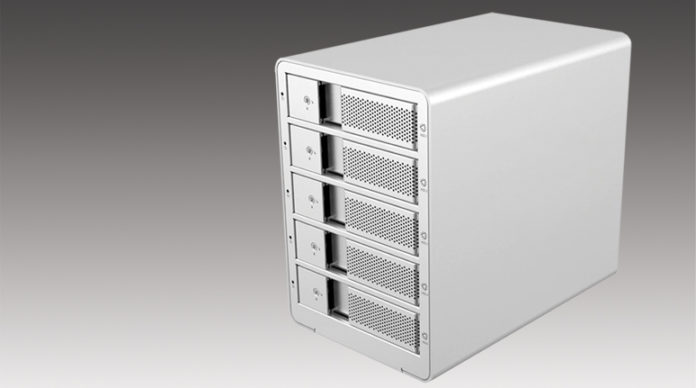by Mark McCall
M. Photog. M. Artist, Cr., CPP
File storage is the 2nd most important item in any photography operation after your camera. Having a dependable storage plan is critical to all photography based businesses and should be thought out carefully. Fortunately, it’s not as expensive or tedious as we tend to make it. I remember taking apart my first computer, an Intel 286 running Windows 2.1x, about 1986. I remember thinking, “Wow, 20 MB of storage. I’ll never need another hard drive.” Today, that wouldn’t even be enough space to store a single image from my camera.
I worked in newsprint back in the early ‘90’s. We were already archiving the daily newspaper on magnetic Colorado Tape Drives which resembled huge 8 track tapes and held only 250 MB. We were just beginning to use electronic pagination in those days, slowly migrating the newspaper to digital production which required a storage system. Tape drives were the way to go in the early days of technology. However, the downside to magnetic tapes is that they weren’t stable. They were sensitive to changes in ambient temperature and could fail over time simply from age. Think of them as an oversized music cassette tape popular in the 80’s. This was very early technology.
In the mid 90’s, we began to migrate to Zip drives which could go as high as 750 MB. They were square, plastic drives that could be written or accessed with a reader that plugged into individual computers or a network. Zip never achieved the popularity of CD’s for storage due to cost. Eventually, CD’s became the storage media of choice due to cost. Whatever we used, “back up” was the name of the game.
Nowadays, we not only require massive amounts of storage space for your digital images, but a quick and easy way to get to those images later on. RAID systems had been in development for a number of years starting in the 70’s but didn’t get worldwide acceptance until the 90’s. RAID stands for Redundant Array of Inexpensive (or independent) Drives. Oddly enough, redundancy wasn’t the reason RAIDS were being developed. the reason was speed. Engineers figured out that information could be retrieved quicker if spread across multiple drives. Redundancy was later engineered in through RAID levels.
RAIDS consist of a stack of hard drives that store images on one of two levels: (1) RAID 0 – Mirroring, or placing the images on more than one drive at the same time. (2) RAID 1 – Striping, or placing part of an image on one drive, then part on another drive. There are many other levels but we are listing the two in the interest of simplicity. We’re also not mentioning SSD drives. This is merely platter style hard drives.
The upside to RAIDS is that it offers a centralized place to put your images for quick retrieval, and minimal maintenance. Space is usually massive which means they can run for years without new drives being added or swapped out. Another advantage is that they offer redundancy, if configured correctly, and are supposed to be able to repopulate themselves if a striped drive fails (I’ve heard success and failure stories).
But here is where the real danger of RAIDS lies. Hard drives, the central component in RAIDS, fail from either heat or use. The heat comes from use, so the very act of using the RAID is what destroys it. Every day that goes by, the propensity for failure goes up. With RAIDS, that’s a lot of days.

In all fairness, this applies to all hard drives. But RAIDS have the dubious honor of being marketed, sold and used as a catch all “use me every day forever” concept. This is bad. At what point in your car’s history do you stop having faith in its reliability? I’ll bet it’s not after 1 or 2 years. No, it’s at year 5, 6, or 7. The same thing goes for RAIDS or anything else with moving parts. The longer it’s used, the higher the propensity for failure. When backing up to a RAID today, you’re spinning up the same set of disks that contains that wedding from 2 or 3 years ago. The disks spun up every time you copied to them.
A dear friend of mine suffered a RAID failure. I’d warned him about the danger many times, but he was convinced it was the most secure system he could buy. The manufacturer of the device had a great reputation. Not only was he unable to retrieve any data from any of the 5 discs in the RAID, the manufacturer was unable to retrieve them as well. Five years of weddings, portraits, senior session right down the drain. Not one image came off that failed RAID.
So what options do we have as photographers? What’s available that is more secure?
My procedure is simple. I’ve always recommended off-the-shelf, USB or Firewire, powered (having an external power cord) external drives, in the lowest capacity I can find. In my opinion, external drives offer the lowest cost vs. benefit per mb. However, it’s getting harder and harder to find drives smaller than 3 TB, although I prefer the 2 TB or smaller. You’ll give up a bit of read/write speed with the plug and play drive, but not enough for it to be a problem. You might not even notice. I regularly work on extremely large PSD’s from external drives as well as doing batch Photoshop work from these drives.
The larger the drive, the longer it takes to fill them up, the higher the propensity for failure. So get the smallest capacity you can find. It’s still a cheaper, more secure option than a RAID. When the drive is about 90% full, shut it down. Buy another. Put a sticker on the drive stating the months that are on it. Power it up only when seeking a file. This keeps the mileage off the drive, which is what would have eventually killed it. With this system you’re not powering up the drives that contain the wedding from 3 years ago, to back up a senior session today. Simple. I have every digital image I’ve ever captured since 2000. And can get to it in 5 minutes or less without a catalog or spreadsheet. That includes client work, print competition and family images.
A few tips that will help with file security…
1. Quarantine memory cards until after the job is delivered to the client.
2. Unplug drives from workstation at night (even if auto-shutdown).
3. Have a second or even a third place for your images besides an external hard drive or RAID. CD, DVD or cloud storage. Medium doesn’t matter as much as simply having a place for them.
4. File your images chronologically rather than by type. File by January, February instead of by Wedding, Portrait, etc.

Mark McCall is a Master Photographer, Photographic Craftsman, and Photographic Artist from Lubbock, Texas. He is a Past President of the Texas Professional Photographers Association and recipient of the National Award from Texas, among other honors. He will once again be teaching the Print Competition Boot Camp at TPPA Summerfest ‘19.











